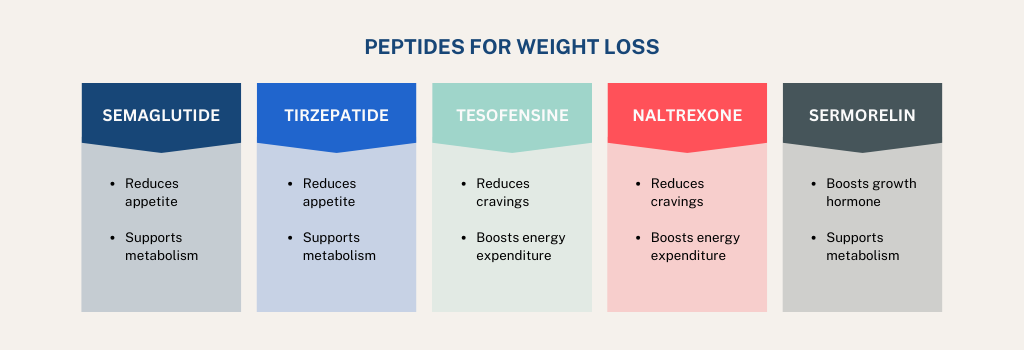If You’re Struggling to Lose Weight, Peptide Therapy Could Help
- By Rebekah Harding
- Fact-checked by Mike Fazioli
- December 28, 2023
30-Second Takeaway
- Peptides are short amino acid chains that support various bodily functions.
- Certain peptides—including semaglutide, tirzepatide, tesofensine, naltrexone, and sermorelin—can support weight loss by regulating appetite, growth hormone levels, and more.
- If you’re prescribed peptides for weight loss, you’ll get the best results by pairing your treatment with a balanced diet and adequate exercise.
I
f weight loss is important to you and you’re struggling to meet your goals, you may have considered buzzy peptide injections such as Ozempic, Wegovy, or Mounjaro. But these aren’t the only effective peptides for weight loss that can help you shed stubborn pounds.
In fact, weight loss experts have been prescribing a wide range of peptides for years—and for good reason. ”Studies have linked peptide therapy to 3 to 12 percent more weight loss than that lost with diet and exercise alone,” says gastroenterologist Ibrahim Hanouneh, M.D.
Peptides and Peptide Therapy
Peptides are short chains of amino acids that function as hormones or enzymes (1). These amino acids help different systems in your body communicate, like telling your cells to divide and multiply, or regulating your endocrine, nervous, and immune systems (2).
“Peptides are used for almost any medical issue,” says regenerative medicine specialist Neil Paulvin, D.O. “Most commonly [it’s used for] inflammation, sports recovery, gut health, brain health and—of course—weight loss.”
About the Experts:
Dr. Ibrahim Hanouneh, M.D., is a gastroenterologist, and co-author of Regenerative Health, with a specialization in weight management, gut health, and liver disease.
Dr. Neil Paulvin, D.O., is a longevity expert and regenerative medicine specialist. He specializes in autoimmune and inflammation-based conditions, gut health, and hormone imbalances.
Peptides for Weight Loss
Many peptides support weight loss—but not all of them are created equally (or safely). Recently, the FDA banned 17 popular peptides due to safety concerns, seven of which were used to support weight loss.
Below are the safest and most effective peptides for weight loss, according to experts.
Just keep in mind that you have to commit to other healthy lifestyle changes—like eating a balanced diet and exercising regularly—to get the most out of peptide therapy, Hanouneh advises.
“The combination of peptide therapy and lifestyle modification leads to greater weight loss than using one intervention alone,” he says.
Semaglutide and tirzepatide
Popular weight loss peptides semaglutide (Ozempic and Wegovy) and tirzepatide (Mounjaro and Zepbound) work in similar ways to support weight loss, notes Hanouneh.
“They both activate receptors of hormones in the brain which lead to appetite suppression and help the body regulate insulin production,” Hanouneh says. “Semaglutide activates the GLP-1 receptor. Tirzepatide targets two receptors—GLP-1 and GIP—leading to greater weight loss [than semaglutide] (3).”
GLP-1 is a hormone that helps control your appetite and regulate blood sugar and metabolic functions (4, 5). When you eat, GLP-1 is released and helps slow the emptying of food from your stomach, which can make you feel full. Semaglutide and tirzepatide bind to GLP-1 receptors in your brain, reducing your appetite and promoting weight loss.
GIP, an anabolic hormone, targets your hypothalamus to make you feel full (6). Tirzepatide binds to GIP receptors, which may increase how much insulin your body makes, reduce LDL (bad) cholesterol levels, and improve blood sugar levels (7).
“These peptide medications work by making you feel less hungry—or less ‘hangry,’” says Hanouneh. This effect can support your weight loss efforts by eliminating the need to resist cravings. In part, this may also help you follow a nutritious meal plan a bit more easily.
Tesofensine
Like semaglutide and terzepatide, tesofensine peptide therapy supports weight loss by pumping the brakes on cravings—but in a slightly different way. Tesofensine influences neurotransmitters like serotonin, norepinephrine, and dopamine, which are partially responsible for hunger (8).
Tesofensine also revs up your body’s energy expenditure (8). This means that even when you’re at rest your body is still burning calories.
Naltrexone
Battling binge eating habits? Research shows that naltrexone can dampen the rewarding feeling that follows overeating, which may help you break the binge cycle (9).
By influencing neurotransmitters like dopamine, which are associated with pleasure and reward, this peptide helps put an end to compulsive cravings, particularly for foods that are high in fat and sugar (10, 11).
Naltrexone may also regulate certain hormones related to energy expenditure, according to a study on male mice, which may help you burn more calories (12).
Sermorelin
Sermorelin is a man-made version of GHRH (growth-hormone-releasing hormone) (13). In a nutshell, sermorelin encourages your body to naturally make more growth hormone (GH), which plays an important role in metabolism and fat burning (14). As you age, your levels of GH start to dip, which is why so many of us deal with weight gain and a slower metabolism as we get older (15). Increasing GHRH signals to your body to make more GH, which can help your metabolism work faster.
When growth hormone levels are increased, it can help your body convert stored fat into energy and preserve lean muscle mass (16). People who take sermorelin may find that this increase in energy makes it easier to be physically active. Having more energy to exercise may also help you shed pounds—and make over your body composition.

Who Should Try Peptides for Weight Loss?
Peptide therapy is effective for most patients, according to Hanouneh. If obesity is something you’ve been struggling with, and diet and exercise has not resulted in weight loss, “you may want to check with your healthcare provider about starting peptide treatment,” he says.
Peptides for weight loss, like semaglutide and tirzepatide, have specific prescribing requirements—like a BMI of 30 or more, or BMI of 27 or more with at least one weight-related condition like pre-diabetes (17, 18). However, others may be more flexible. If you’re considering peptides for weight loss, talk to your GP about your goals and which peptide may work best for your body.
Plus, Hanouneh says that peptide therapy can “kill two birds with one stone” if you are struggling with other conditions linked to obesity, such as type II diabetes (19).
The exceptions: Women shouldn’t take weight-loss medications while pregnant, breastfeeding, or trying to get pregnant. He also avoids prescribing peptides to patients with a family history (or personal health history) of thyroid cancer, as some peptide therapies have been linked to an increased risk for thyroid tumors (20).
References
1. Forbes, et al (2023). Biochemistry, Peptide.
2. Khavinson, et al (2021). Peptide Regulation of Gene Expression: A Systematic Review.
3. Azuri, et al (2022). Tirzepatide versus semaglutide for weight loss in patients with type 2 diabetes mellitus: A value for money analysis.
4. Iqbal, et al (2022). Effect of glucagon-like peptide-1 receptor agonists on body weight in adults with obesity without diabetes mellitus—a systematic review and meta-analysis of randomized control trials.
5. Aldawsari, et al (2023). The Efficacy of GLP-1 Analogues on Appetite Parameters, Gastric Emptying, Food Preference and Taste Among Adults with Obesity: Systematic Review of Randomized Controlled Trials.
6. Douros, et al (2020). Tirzepatide is an imbalanced and biased dual GIP and GLP-1 receptor agonist.
7. Forzano, et al (2022). Tirzepatide: A Systematic Update.
8. Perez, et al (2023). Tesofensine, a novel antiobesity drug, silences GABAergic 2 hypothalamic neurons
9. Spencer, et al (2023). Naltrexone engages a brain reward network in the presence of reward-predictive distractor stimuli in males.
10. Jayaram, et al (2017). Naltrexone modulates dopamine release following chronic, but not acute amphetamine administration: a translational study.
11. Mason, et al (2016). Putting the brakes on the “drive to eat”: Pilot effects of naltrexone and reward based eating on food cravings among obese women.
12. Panigrahi, et al (2019). Effects of Naltrexone on Energy Balance and Hypothalamic Melanocortin Peptides in Male Mice Fed a High-Fat Diet.
13. ScienceDirect. Sermorelin.
14. Donato, et al (2020). Central Regulation of Metabolism by Growth Hormone.
15. Garcia, et al (2019). Growth Hormone in Aging.
16. Kopchick, et al (2020). The effects of growth hormone on adipose tissue: old observations, new mechanisms
17. McGowan, et al (2023). Impact of BMI and comorbidities on efficacy of once-weekly semaglutide: Post hoc analyses of the STEP 1 randomized trial
18. FDA. FDA Approves New Medication for Chronic Weight Management.
19. Scheen (2019). [Semaglutide, once weekly GLP-1 receptor agonist (Ozempic®)]
20. MedlinePlus. Semaglutide Injection.












